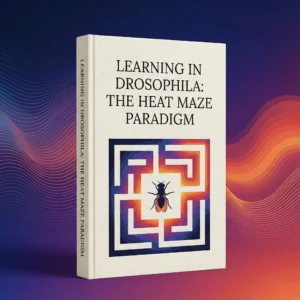
At first glance, escape latency appears to be a straightforward measurement—the number of seconds it takes for a zebrafish to reach a goal in the Visual Water Maze. But this simple metric conceals a cascade of complex neurobiological, psychological, and behavioral processes. In reality, escape latency captures a rich interplay of sensory perception, spatial cognition, executive control, and motivated behavior, making it one of the most holistic indicators of cognitive function in zebrafish research.
The process begins the moment the zebrafish is introduced into the maze. It must perceive and process visual stimuli, orient itself in space, and determine a strategy to navigate the environment. Zebrafish are particularly reliant on vision—a trait that makes them ideally suited for this task. They interpret contrasting wall patterns, light gradients, and geometric cues to form a mental representation of the maze.
Escape latency, therefore, is not just a record of time—it is a reflection of how quickly and accurately the fish can convert raw sensory input into navigational decisions.
To reach the goal platform efficiently, zebrafish must engage both working memory (temporary holding of spatial information during each trial) and reference memory (long-term retention of the platform’s location across trials). The dorsolateral telencephalon, often likened to the mammalian hippocampus, plays a central role in this mnemonic process (Rodríguez et al., 2002).
A high escape latency may indicate a breakdown in any of these memory systems. For example, a fish that learned the correct location in previous sessions but shows a latency increase during probe trials may be exhibiting memory decay or retrieval interference.
Zebrafish are not passive agents in the maze—they exhibit decision-making behaviors. In early trials, escape behavior may appear random or exploratory. However, as the fish becomes familiar with the spatial arrangement, it begins to adopt more efficient strategies: direct swimming toward the platform, reliance on specific visual cues, or predictive turning behaviors.
The transition from high to low escape latency represents more than learning—it reveals cognitive flexibility and strategic refinement. Some studies even classify search strategies using machine learning to further interpret what escape latency signifies about decision-making quality.
Latency is also shaped by internal states. Anxiety, stress, or low motivation can significantly prolong the time it takes a fish to act, regardless of cognitive ability. Zebrafish are known to display thigmotaxis (wall-hugging behavior) under stress, which can lead to longer escape latencies simply due to avoidance of the center zone where the platform is typically placed (Blaser & Gerlai, 2006).
Thus, researchers must interpret high escape latency with nuance: Is it cognitive deficit, emotional reactivity, or motor inhibition? This distinction is especially critical when evaluating drug effects or genetic manipulations.
In the final leg of the task, motor execution must align with cognitive intent. If a zebrafish has learned the platform location but is physically impaired—due to injury, fatigue, or sedative exposure—escape latency may remain high despite intact memory. For this reason, control measures such as swim velocity, path linearity, and erratic movement indices are essential to distinguish true cognitive impairment from non-cognitive influences.
This interpretative complexity is why many laboratories now co-analyze escape latency with additional behavioral outputs, such as heat maps, path plots, and exploratory metrics, to create a more complete cognitive profile.
Ultimately, escape latency offers a convergent behavioral readout of an entire cognitive circuit. It reflects:
This systemic nature makes escape latency uniquely sensitive to a broad range of cognitive disruptions. It is not surprising that this metric is commonly used in models of Alzheimer’s disease, autism spectrum disorder, schizophrenia, and neurotoxic exposure, where learning and memory are key domains of dysfunction (de Esch et al., 2012; Stewart et al., 2015).
Escape latency bridges the observable with the invisible—it links what we can measure with what we seek to understand. It condenses the brain’s decision-making processes into a single, reproducible number, offering both simplicity in collection and depth in interpretation.
As zebrafish models evolve to include real-time calcium imaging, optogenetics, and whole-brain mapping, researchers are beginning to correlate escape latency with neural activity patterns, bringing behavioral metrics and neuronal data into alignment (Ahrens et al., 2013). In this sense, latency is no longer just a stopwatch measure—it’s a portal into the brain’s inner workings.
In a typical VWM protocol, zebrafish are placed into a circular or square tank containing a submerged escape platform located consistently in one position relative to visual cues. The tank walls display distinctive patterns or symbols, enabling the fish to associate the platform location with specific visual stimuli.
During acquisition trials, the platform is present, and latency to reach it is recorded. During probe trials, the platform is removed to test memory retention based on search behavior and latency.
Escape latency is most informative when viewed across repeated trials. Early sessions often show erratic swimming, high thigmotaxis, and longer latencies. However, with training, zebrafish typically show:
This downward trend in latency provides strong evidence for spatial learning and associative memory formation.
Escape latency serves not just as a behavioral endpoint, but as a biological readout of brain function shaped by genetics. In recent years, advances in neurogenetics have transformed the zebrafish Visual Water Maze (VWM) into a high-throughput assay for decoding the genetic architecture of learning and memory. Researchers can now ask: Which genes influence cognition? How do mutations manifest behaviorally? What molecular disruptions underlie extended escape latency?
The zebrafish—compact, transparent, and genetically tractable—offers a unique platform for answering these questions. Coupled with the VWM, escape latency becomes a quantifiable phenotype for probing the neurological consequences of gene mutations, environmental exposures, or therapeutic interventions.
Numerous genes conserved between zebrafish and humans are implicated in neurodevelopmental and neurodegenerative disorders. Many of these genes influence synaptic transmission, neuroplasticity, or neurogenesis—domains closely tied to performance in spatial learning tasks like the VWM.
These models demonstrate how escape latency directly translates molecular disruptions into observable behavioral phenotypes, enabling researchers to study cognition in a genetic context.
The CRISPR/Cas9 system has revolutionized zebrafish neurogenetics, allowing precise editing of single genes to create knockout or knock-in lines. Researchers can now generate targeted mutations and use escape latency as a screening tool for cognitive consequences.
For example:
In this context, latency functions not just as a behavioral measure, but as a biomarker for circuit-level dysfunction. When paired with imaging techniques or electrophysiology, these models offer comprehensive insight into how genes regulate learning and memory at multiple levels—from synapse to behavior.
Zebrafish are ideal for pharmacogenetic studies, where gene function is interrogated in the presence of pharmacological agents. Escape latency becomes a sensitive indicator of drug effects on learning and memory, particularly when examining gene-drug interactions.
These studies enable rapid preclinical screening of nootropic or neuroprotective compounds in a genetically defined context—something not easily achievable in rodent systems due to time, cost, and throughput limitations.
Emerging techniques such as tissue-specific gene knockdown, transgenic calcium imaging, and single-cell RNA-seq allow researchers to correlate escape latency with gene activity in defined brain regions.
Key zebrafish brain structures involved in escape latency include:
Manipulating gene expression in these regions using Gal4/UAS systems or conditional promoters allows for regional mapping of genetic control over cognitive behaviors. Prolonged escape latency in region-specific knockdown models pinpoints which parts of the brain are necessary for successful learning.
One of the most exciting frontiers is the use of zebrafish escape latency to model human patient-derived mutations. With the rise of precision medicine, researchers are now introducing variants of unknown significance (VUS) found in patient genomes into zebrafish lines.
By measuring escape latency, scientists can assess whether a novel mutation leads to cognitive dysfunction—providing functional annotation for variants and guiding clinical interpretation.
This approach transforms the Visual Water Maze into a functional genomics platform, bridging basic neuroscience with real-world patient data.
Neurogenetics turns escape latency from a behavioral metric into a biological instrument, capable of probing the effects of gene expression, mutation, modulation, and rescue. It allows researchers to navigate the complex terrain between molecular architecture and cognitive performance, and to functionally annotate genes that were once statistical signals in genome-wide studies.

Escape latency’s utility depends on the quality of the experimental design. Researchers should consider the following:
High-contrast, consistently placed cues help zebrafish learn faster and reduce variability in escape latency.
Prior habituation to the testing tank reduces anxiety-induced thigmotaxis, enabling clearer cognitive assessment.
Latency must be interpreted in light of swim speed. If a fish swims slowly or erratically due to stress, illness, or sedative exposure, longer latency may not reflect cognitive impairment per se. Including swim velocity as a covariate during analysis can correct for this.
While the avoidance of open spaces or light may motivate escape, using mild aversive stimulation (e.g., bright light) can enhance performance while maintaining ethical standards.
While escape latency is powerful on its own, it becomes even more informative when paired with:
Together, these metrics create a multi-dimensional profile of cognitive performance.
The zebrafish VWM and its reliance on escape latency have strong translational value:
These parallels help bridge the gap between basic neuroscience and clinical neuropsychology, positioning zebrafish VWM data as relevant for understanding psychiatric and neurodegenerative disease mechanisms.
Modern behavioral analysis platforms now allow for automated video tracking and integration with AI-powered behavior classifiers. Researchers can:
Escape latency remains the core metric, but machine vision unlocks latent behavioral dimensions, offering unprecedented detail.
Escape latency in the Visual Water Maze is far more than a behavioral timestamp—it is a comprehensive index of cognitive processing, shaped by genetics, environment, neurochemistry, and experience. When interpreted thoughtfully, it provides researchers with reliable, scalable, and meaningful data on the cognitive status of zebrafish.
In a landscape where neurobehavioral disorders continue to rise, and traditional models face ethical and translational challenges, zebrafish VWM protocols centered around escape latency offer a sustainable, high-throughput, and biologically rich alternative for neuroscience research.
Written by researchers, for researchers — powered by Conduct Science.
